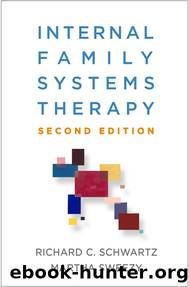Internal Family Systems Therapy by Richard C. Schwartz

Author:Richard C. Schwartz [Sweezy, Martha]
Language: eng
Format: epub
Publisher: The Guilford Press
Burdens Resulting from Trauma
Family dynamics and bias are not alone in creating burdens. When people get rejected, neglected, abandoned, shocked, scared, or abused (physically, sexually, or emotionally), their injured parts are quickly sequestered and their inner systems polarize. We can testify that numerous traumatized clients have taught IFS practitioners about the kinds of burdening, imbalance, and polarization that typically result from trauma. When a human systemâbe it individual, family, community, or countryâsuffers a threat or an overwhelming trauma, it organizes to protect its leadership and its most vulnerable members. For example, if one country threatens another, the threatened country will move its leaders to a safe place. At the same time, civilians will be sent to shelters, and the military will take over. If the leader stays calm, providing a sense of strength and comfort while the crisis is resolved, the publicâs trust in the leader is likely to increase. In contrast, the leader who is not able to prevent devastating losses will lose credibility, and the military will likely stay in power.
Internal families operate the same way. Letâs consider an inner family that includes members of various ages and degrees of vulnerability. In the face of danger, the family moves the Self as well as the systemâs most vulnerable parts to safety while protective parts step forward. Traumatized clients have taught us that before or during trauma the inner family separates the Self from the sensations of the body to varying degrees (depending on how severe they judge the danger to be)âsometimes pushing it out of the body altogetherâand some of the older members take control to protect the system with fight-or-flight responses: lashing out or escaping while more vulnerable parts freeze. These front-line protectors aim to minimize sensations of terror and pain for the system and the Self.
Despite these efforts, the youngest, most vulnerable members of the inner family are powerfully affected by traumatic events. They feel injury, abandonment, and betrayal acutely. When the stimulus is intense enough, vulnerable parts freeze in time and experience a kind of endless Groundhog Day repetition of the trauma, complete with all of its sensations and feelings. By contrast, if the Self can stay embodied and offer immediate assistance, the systemâs trust in Self-leadership increases, building inner strength and opposing tendencies to polarize, all of which helps injured parts avoid being exiled and instead stay in the stream of time.
Although Self-leadership throughout a crisis is ideal, the Self cannot always lead during trauma. If the victim is an infant or child, much depends on the reactions of those around her. For example, when a child is returned to safety, comforted, loved, and helped to understand and accept what happened, her Self will also stay available, and will respond to hurt parts inside with love, comfort, and acceptance. In the best-case scenario, the childâs experience is validated, and injured parts unburden spontaneously. If, however, the Self is impotent to protect the system and cannot help traumatized parts after the fact, the inner family will lose trust and become overprotective of both the Self and injured parts.
Download
This site does not store any files on its server. We only index and link to content provided by other sites. Please contact the content providers to delete copyright contents if any and email us, we'll remove relevant links or contents immediately.
Rewire Your Anxious Brain by Catherine M. Pittman(17635)
Talking to Strangers by Malcolm Gladwell(11981)
The Art of Thinking Clearly by Rolf Dobelli(8923)
Mindhunter: Inside the FBI's Elite Serial Crime Unit by John E. Douglas & Mark Olshaker(7893)
Becoming Supernatural by Dr. Joe Dispenza(7158)
Change Your Questions, Change Your Life by Marilee Adams(6702)
The Road Less Traveled by M. Scott Peck(6685)
Nudge - Improving Decisions about Health, Wealth, and Happiness by Thaler Sunstein(6682)
The Lost Art of Listening by Michael P. Nichols(6526)
Enlightenment Now: The Case for Reason, Science, Humanism, and Progress by Steven Pinker(6446)
Win Bigly by Scott Adams(6356)
Mastermind: How to Think Like Sherlock Holmes by Maria Konnikova(6293)
The Way of Zen by Alan W. Watts(5843)
Daring Greatly by Brene Brown(5692)
Big Magic: Creative Living Beyond Fear by Elizabeth Gilbert(4779)
Grit by Angela Duckworth(4775)
Men In Love by Nancy Friday(4381)
Flow by Mihaly Csikszentmihalyi(4093)
The Four Tendencies by Gretchen Rubin(4057)
